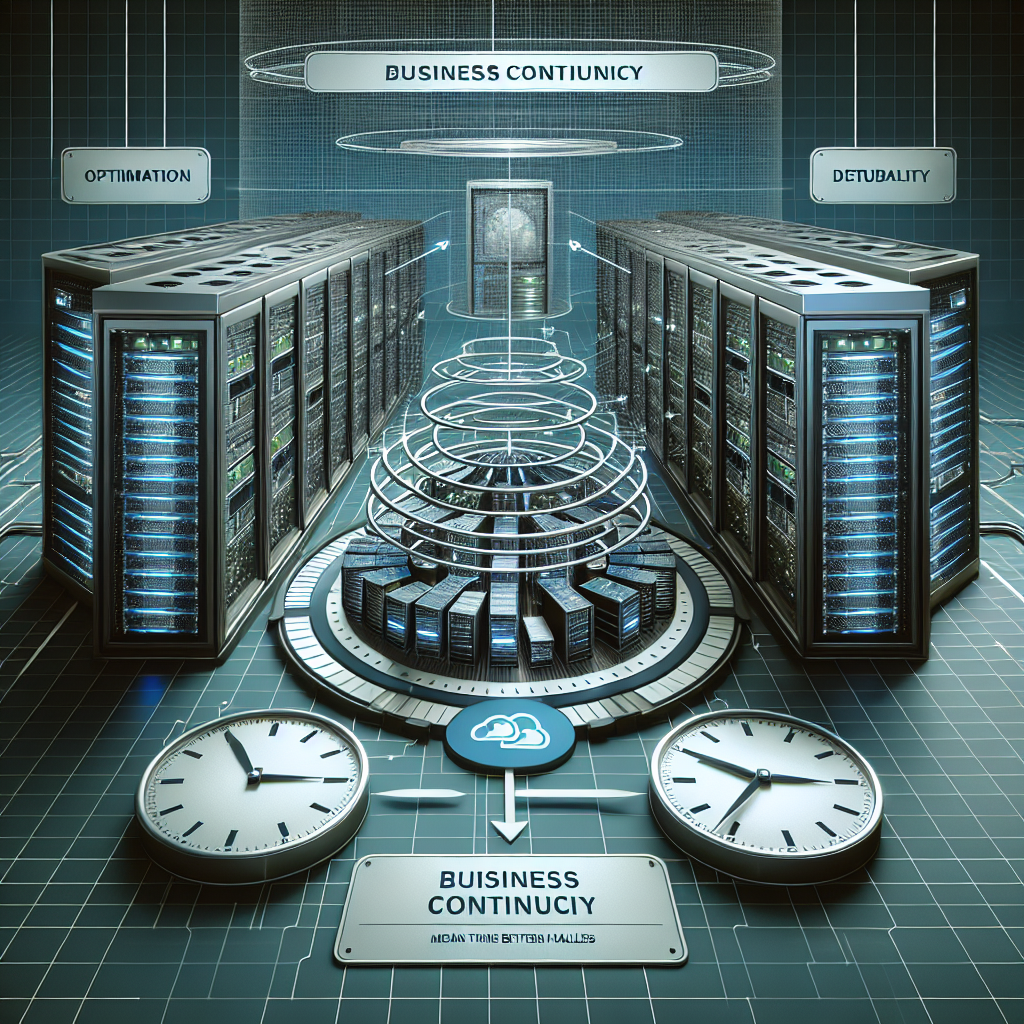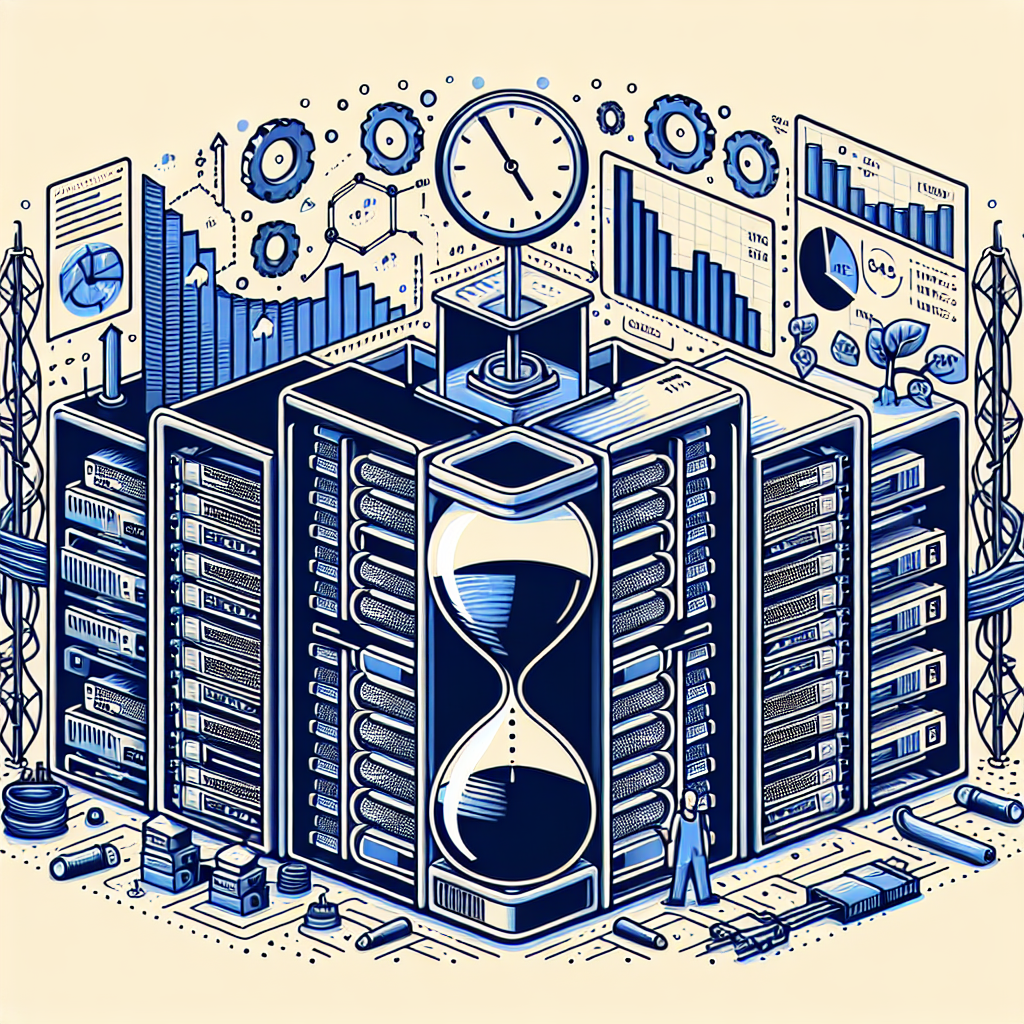Your cart is currently empty!
Tag: Downtime

The Hidden Risks of Data Center Downtime: Why Redundancy is Key
In today’s digital age, data centers have become the backbone of businesses, storing and processing vast amounts of critical information. However, with this reliance on data centers comes the risk of downtime, which can have serious consequences for organizations. In fact, according to a recent study by Ponemon Institute, the average cost of data center downtime is $740,357 per incident.There are a number of factors that can cause data center downtime, including power outages, hardware failures, and cyber attacks. Regardless of the cause, the impact of downtime can be severe. Beyond the financial costs, downtime can also damage a company’s reputation, erode customer trust, and lead to lost productivity.
One of the key ways to mitigate the risks of data center downtime is through redundancy. Redundancy refers to the practice of having backup systems and components in place to ensure continuous operation in the event of a failure. This can include redundant power supplies, cooling systems, and network connections.
By implementing redundancy in their data centers, organizations can greatly reduce the likelihood of downtime and minimize its impact if it does occur. For example, if a power outage were to occur, a data center with redundant power supplies would be able to switch to a backup power source seamlessly, ensuring that critical systems remain operational.
In addition to hardware redundancy, organizations should also consider implementing redundancy in their data center design and location. This can include having multiple data centers in different geographic locations to ensure continuity in the event of a natural disaster or other regional event.
While implementing redundancy may require additional upfront investment, the costs of downtime far outweigh the costs of redundancy. By investing in redundancy, organizations can protect their critical systems and data, minimize the risks of downtime, and ensure business continuity in the face of unforeseen events.
In conclusion, the risks of data center downtime are significant and can have serious consequences for organizations. By implementing redundancy in their data centers, organizations can greatly reduce the likelihood of downtime and protect their critical systems and data. Redundancy is key to ensuring business continuity and mitigating the risks of data center downtime in today’s digital age.

The Cost of Downtime: Why Data Center Resilience is Crucial
In today’s digital age, businesses rely heavily on data centers to store, manage, and process vast amounts of information. Whether it’s customer data, financial records, or operational data, the smooth operation of a data center is crucial for the success of any organization. However, what happens when a data center experiences downtime? The cost of downtime can be significant, both financially and in terms of reputation.Data center downtime refers to the period of time when a data center is not operational, either due to equipment failure, power outages, human error, or natural disasters. During this time, businesses are unable to access critical data and applications, leading to disruptions in operations, loss of revenue, and damage to the organization’s reputation.
The financial impact of data center downtime can be staggering. According to a study by the Ponemon Institute, the average cost of data center downtime is $740,357 per incident. This includes direct costs such as lost revenue, increased IT support costs, and penalties for breaching service level agreements. Indirect costs, such as damage to the organization’s reputation, loss of customer trust, and decreased employee productivity, can also have a significant impact on the bottom line.
To mitigate the risk of data center downtime, organizations must invest in data center resilience. Data center resilience refers to the ability of a data center to withstand and recover from disruptions, ensuring continuous operation and availability of critical data and applications. This includes implementing redundant power supplies, backup generators, cooling systems, and network connections to minimize the impact of potential failures.
In addition to implementing resilient infrastructure, organizations must also have a comprehensive disaster recovery plan in place. This includes regularly backing up data, testing backup systems, and developing protocols for responding to and recovering from data center disruptions. By taking proactive measures to enhance data center resilience, organizations can minimize the risk of downtime and reduce the financial and reputational costs associated with data center disruptions.
In conclusion, the cost of data center downtime is substantial, both in terms of financial losses and damage to an organization’s reputation. Investing in data center resilience is crucial for mitigating the risk of downtime and ensuring the continuous operation of critical data and applications. By implementing resilient infrastructure and developing a comprehensive disaster recovery plan, organizations can minimize the impact of data center disruptions and protect their bottom line.

The Power of Root Cause Analysis in Preventing Data Center Downtime
Data center downtime can have a significant impact on businesses, leading to lost revenue, decreased productivity, and damaged reputation. In today’s digital age, where data is king, any interruption in data center operations can have far-reaching consequences. One of the most effective ways to prevent data center downtime is through the use of root cause analysis.Root cause analysis is a systematic process used to identify the underlying causes of problems or failures. By digging deep into the root causes of an issue, organizations can implement targeted solutions to prevent similar incidents from occurring in the future. In the context of data centers, root cause analysis can be a powerful tool in identifying and addressing issues that could lead to downtime.
One of the key benefits of root cause analysis in preventing data center downtime is that it helps organizations move beyond simply addressing symptoms of a problem. Instead of just fixing the immediate issue, root cause analysis allows organizations to identify the underlying factors that contributed to the problem in the first place. By addressing these root causes, organizations can implement more effective and long-lasting solutions that can prevent downtime from occurring in the future.
Root cause analysis also helps organizations to prioritize their efforts in preventing data center downtime. By identifying the root causes of past incidents, organizations can focus their resources on addressing the most critical issues that are likely to lead to downtime. This targeted approach allows organizations to make the most of their resources and ensure that they are addressing the most pressing concerns first.
Furthermore, root cause analysis can help organizations to improve their overall data center operations. By identifying and addressing root causes of downtime, organizations can implement changes to their processes, procedures, and infrastructure that can enhance the reliability and resilience of their data centers. This proactive approach can help organizations to prevent downtime before it occurs, rather than simply reacting to incidents as they happen.
In conclusion, the power of root cause analysis in preventing data center downtime cannot be overstated. By identifying and addressing the underlying causes of problems, organizations can implement targeted solutions that can prevent downtime from occurring in the future. Root cause analysis helps organizations to prioritize their efforts, improve their operations, and ultimately ensure the continued availability and reliability of their data centers. By making root cause analysis a key part of their data center management practices, organizations can proactively prevent downtime and minimize the impact of any incidents that do occur.

Preventing Data Center Downtime: Best Practices for Effective Disaster Recovery Planning
Data centers are the backbone of modern businesses, housing the critical infrastructure and data that keep organizations running smoothly. However, despite their importance, data centers are not immune to downtime. Whether caused by natural disasters, power outages, hardware failures, or human error, data center downtime can have catastrophic consequences for businesses, leading to lost revenue, damaged reputation, and even legal implications.To prevent data center downtime and protect your organization from the costly repercussions, it is essential to have an effective disaster recovery plan in place. Here are some best practices for creating a comprehensive disaster recovery plan that will minimize the risk of downtime and ensure business continuity.
1. Conduct a thorough risk assessment: Before creating a disaster recovery plan, it is crucial to identify and assess potential risks that could lead to data center downtime. Consider factors such as location, environmental threats, hardware vulnerabilities, human error, and cybersecurity risks. Understanding these risks will help you prioritize your disaster recovery efforts and allocate resources effectively.
2. Develop a robust backup strategy: Regularly backing up critical data and systems is essential for disaster recovery planning. Implement a multi-tiered backup strategy that includes on-site and off-site backups, as well as cloud backups for added redundancy. Test your backup systems regularly to ensure they are functioning correctly and can be quickly restored in the event of a disaster.
3. Implement high availability solutions: To minimize the risk of downtime, consider implementing high availability solutions such as redundant power supplies, uninterruptible power supplies (UPS), backup generators, redundant network connections, and failover systems. These technologies can help ensure continuous operation of critical systems even in the event of a hardware failure or power outage.
4. Create a detailed disaster recovery plan: Develop a comprehensive disaster recovery plan that outlines specific procedures to follow in the event of a data center outage. Include contact information for key personnel, step-by-step recovery instructions, and a timeline for restoring operations. Regularly review and update the plan to reflect changes in technology, infrastructure, and business needs.
5. Test your disaster recovery plan: Regularly test your disaster recovery plan through simulated drills and exercises to ensure that all systems and personnel are prepared to respond effectively in the event of a real disaster. Identify and address any weaknesses or gaps in your plan to improve its effectiveness and minimize downtime.
6. Monitor and analyze performance: Implement monitoring tools and performance metrics to track the health and performance of your data center infrastructure. Proactively identify and address potential issues before they lead to downtime, and use data analytics to optimize your disaster recovery plan and improve resilience.
By following these best practices for effective disaster recovery planning, you can minimize the risk of data center downtime and protect your organization from the costly consequences of unplanned outages. Investing in a robust disaster recovery plan is essential for ensuring business continuity and maintaining the trust of your customers and stakeholders.

The Costs of Downtime: Why Investing in Data Center Uptime is Worth It
In today’s digital age, downtime is a costly and inconvenient reality for businesses that rely on data centers to keep their operations running smoothly. Whether it’s due to a power outage, equipment failure, or a cyber attack, downtime can have a significant impact on a company’s bottom line. That’s why investing in data center uptime is crucial for businesses looking to minimize the costs associated with downtime.The costs of downtime can be substantial, both in terms of lost revenue and damage to a company’s reputation. According to a recent study by the Ponemon Institute, the average cost of downtime for a business is around $9,000 per minute. This can add up quickly, with some businesses losing hundreds of thousands of dollars in just a single hour of downtime.
But the financial costs are just the tip of the iceberg when it comes to the impact of downtime. Downtime can also result in lost productivity, missed deadlines, and frustrated customers. In today’s fast-paced business environment, any disruption to operations can have a ripple effect throughout the entire organization.
Investing in data center uptime is one way that businesses can mitigate the risks associated with downtime. By ensuring that their data centers are equipped with the latest technology and security measures, businesses can minimize the likelihood of experiencing downtime in the first place. This can include implementing redundant power sources, backup generators, and advanced monitoring systems to quickly identify and resolve any issues that may arise.
While investing in data center uptime may require an upfront investment, the long-term benefits far outweigh the costs. By minimizing the risks of downtime, businesses can improve their operational efficiency, enhance their customer satisfaction, and protect their bottom line. In today’s competitive business landscape, investing in data center uptime is a smart decision that can pay off in the long run.

The Importance of Data Center MTBF in Preventing Downtime and Ensuring Business Continuity
In today’s digital age, data centers play a crucial role in the operations of businesses of all sizes. These facilities house the servers, storage systems, networking equipment, and other critical infrastructure that allow organizations to store, process, and transmit data. As such, ensuring the reliability and availability of data center operations is paramount to the success of any business.One key metric that data center operators use to measure the reliability of their infrastructure is Mean Time Between Failures (MTBF). MTBF is a measure of the average time between failures of a system or component. In the context of data centers, MTBF is typically used to assess the reliability of critical components such as servers, storage systems, and power distribution units.
Having a high MTBF for data center components is essential for preventing downtime and ensuring business continuity. Downtime can be costly for businesses, leading to lost productivity, revenue, and customer trust. In fact, according to a report by the Ponemon Institute, the average cost of data center downtime is around $9,000 per minute.
By monitoring and improving the MTBF of data center components, operators can proactively identify potential failure points and take preventive measures to minimize the risk of downtime. This can involve implementing redundant systems, performing regular maintenance and testing, and investing in high-quality, reliable equipment.
In addition to preventing downtime, a high MTBF can also help businesses meet their Service Level Agreements (SLAs) and maintain a competitive edge in the market. Customers expect their data to be available whenever they need it, and any disruptions in service can lead to dissatisfaction and loss of business.
Furthermore, in industries such as finance, healthcare, and e-commerce, where data security and compliance are critical, a reliable data center with a high MTBF is essential for protecting sensitive information and maintaining regulatory compliance.
In conclusion, the importance of data center MTBF in preventing downtime and ensuring business continuity cannot be overstated. By investing in reliable infrastructure, monitoring MTBF metrics, and taking proactive measures to address potential failure points, businesses can minimize the risk of downtime, meet customer expectations, and maintain a competitive edge in today’s digital economy.

The Benefits of Proactive Maintenance: Improving Efficiency and Reducing Downtime
Proactive maintenance is a strategy that focuses on preventing equipment failure before it occurs, rather than waiting for something to break down and then fixing it. This approach has numerous benefits for businesses, including improved efficiency and reduced downtime.One of the primary advantages of proactive maintenance is that it helps to identify potential issues before they become serious problems. By regularly inspecting and maintaining equipment, businesses can catch small issues early on and address them before they escalate into major failures. This can not only save businesses time and money on costly repairs, but also prevent unexpected downtime that can disrupt operations and lead to lost productivity.
In addition to preventing breakdowns, proactive maintenance can also help businesses optimize the performance of their equipment. By regularly inspecting and fine-tuning machinery, businesses can ensure that it is operating at peak efficiency, which can lead to lower energy costs and improved overall productivity. This can also extend the lifespan of equipment, reducing the need for costly replacements and upgrades.
Another benefit of proactive maintenance is that it can improve workplace safety. Regular maintenance can help to identify and address potential safety hazards, such as faulty wiring or leaky pipes, before they cause accidents or injuries. By maintaining a safe working environment, businesses can protect their employees and avoid costly legal ramifications.
Overall, proactive maintenance is a proactive approach to equipment management that can have a significant impact on a business’s bottom line. By preventing breakdowns, optimizing performance, and ensuring workplace safety, businesses can improve efficiency, reduce downtime, and ultimately increase their profitability. Investing in proactive maintenance is a smart decision for any business looking to stay competitive in today’s fast-paced market.

Preventing Downtime: The Role of Preventative Maintenance in Data Center Operations
In today’s digital age, data centers play a critical role in the operations of businesses and organizations. From storing sensitive information to hosting websites and applications, data centers are the backbone of modern technology. However, downtime can be a costly and detrimental issue for data center operators. Preventative maintenance plays a crucial role in preventing downtime and ensuring the smooth operation of data centers.Preventative maintenance involves regularly inspecting, testing, and servicing equipment to identify and address potential issues before they escalate into problems that could lead to downtime. By implementing a proactive maintenance strategy, data center operators can minimize the risk of unexpected failures and downtime, ultimately saving time, money, and resources.
One of the key benefits of preventative maintenance is the ability to detect and address issues early on, before they have a chance to impact the operation of the data center. By conducting routine inspections and performing regular maintenance tasks, operators can identify worn-out components, loose connections, or other potential problems that could cause equipment failures or malfunctions. Addressing these issues promptly can prevent downtime and ensure the continued operation of the data center.
Preventative maintenance also helps to extend the life of equipment and reduce the risk of costly repairs or replacements. By keeping equipment in good working condition through regular maintenance, data center operators can prolong the lifespan of their assets and avoid the need for expensive repairs or replacements down the line. This not only saves money but also ensures the reliability and efficiency of the data center’s operations.
In addition to preventing downtime and extending equipment life, preventative maintenance can also improve the overall performance of a data center. By keeping equipment clean, well-maintained, and properly calibrated, operators can ensure that their systems operate at peak efficiency, providing optimal performance and reliability. This can lead to increased productivity, improved customer satisfaction, and a competitive edge in the market.
To effectively implement preventative maintenance in data center operations, operators should develop a comprehensive maintenance plan that outlines the tasks, schedules, and responsibilities for maintenance activities. Regularly scheduled inspections, testing, and servicing of equipment should be conducted to identify and address potential issues before they become critical. Operators should also keep detailed records of maintenance activities and equipment performance to track trends, identify patterns, and make informed decisions about future maintenance needs.
In conclusion, preventative maintenance plays a vital role in preventing downtime and ensuring the smooth operation of data centers. By implementing a proactive maintenance strategy, data center operators can minimize the risk of unexpected failures, extend equipment life, improve performance, and ultimately save time, money, and resources. By investing in preventative maintenance, data center operators can protect their assets, enhance their operations, and stay ahead of the competition in today’s fast-paced digital landscape.

Reducing Downtime: How to Decrease Data Center MTTR
Downtime in a data center can be a costly and frustrating experience for businesses. It not only disrupts operations but can also lead to financial losses and damage to reputation. One of the key metrics used to measure the efficiency of a data center is the Mean Time to Repair (MTTR), which is the average time taken to restore services after an outage.Reducing MTTR is crucial for minimizing downtime and ensuring smooth operations of a data center. Here are some strategies that can help decrease data center MTTR:
1. Implement proactive monitoring: Monitoring systems can help detect issues before they cause downtime. By keeping an eye on key performance indicators and alerting staff to potential problems, IT teams can take preemptive action to prevent outages.
2. Invest in automation: Automation tools can streamline the troubleshooting process and help resolve issues faster. Automated scripts can be used to perform routine tasks, identify problems, and even implement fixes without human intervention.
3. Train staff: Well-trained and knowledgeable staff are essential for quick and effective problem resolution. Investing in training programs for IT personnel can help them understand the infrastructure better and respond efficiently to issues.
4. Create a comprehensive incident response plan: Having a well-defined incident response plan in place can help teams act quickly and effectively during an outage. The plan should outline roles and responsibilities, escalation procedures, and steps to be taken to restore services.
5. Conduct regular maintenance: Regular maintenance and checks can help identify potential issues early on and prevent them from causing downtime. Scheduled maintenance tasks should be planned and executed to keep the data center running smoothly.
6. Implement redundancy and failover mechanisms: Redundant systems and failover mechanisms can help minimize downtime by ensuring that services are automatically switched to backup systems in case of a failure. This can help maintain continuity of operations and reduce the impact of outages.
By implementing these strategies, data center operators can reduce MTTR and minimize downtime, ensuring that their operations run smoothly and efficiently. Investing in proactive monitoring, automation, staff training, incident response planning, maintenance, and redundancy can help businesses maintain high availability and reliability of their data center services.

The Real Cost of Data Center Downtime: Calculating the Financial and Reputational Damage
Data centers are the backbone of modern businesses, housing the critical IT infrastructure that keeps operations running smoothly. However, despite their importance, data center downtime is a common occurrence that can have severe financial and reputational implications for organizations.The financial impact of data center downtime can be staggering. According to a report by the Ponemon Institute, the average cost of a data center outage is $9,000 per minute. This means that even a short period of downtime can result in significant financial losses for a company. In fact, the same report found that the average total cost of a single data center outage is over $740,000.
But the financial costs are just the tip of the iceberg when it comes to the true cost of data center downtime. The reputational damage that can result from a data center outage can be even more devastating. Customers today expect 24/7 access to services and products, and any disruption in service can lead to a loss of trust and loyalty.
In a digital age where news spreads rapidly through social media and online forums, a data center outage can quickly become a public relations nightmare. Customers may take to social media to vent their frustrations, leading to negative press coverage and a tarnished reputation for the company.
In addition to the financial and reputational costs, there are also intangible costs associated with data center downtime. These include lost productivity, missed opportunities, and decreased employee morale. When critical systems are down, employees are unable to perform their jobs effectively, leading to a decrease in overall productivity.
So, how can organizations calculate the true cost of data center downtime? One approach is to use a downtime calculator, which takes into account factors such as revenue loss, employee productivity, and reputational damage. By inputting these variables, organizations can get a clearer picture of the financial and reputational impact of a data center outage.
Ultimately, the real cost of data center downtime goes far beyond just the financial losses. It can have a lasting impact on a company’s reputation, customer trust, and employee morale. By understanding the full scope of the consequences of downtime, organizations can better prepare for and mitigate the risks associated with data center outages.
